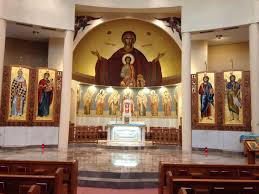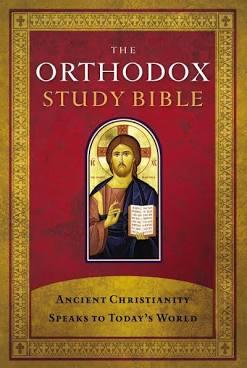But first:
Last week I wished that our Hierarchs would at least consider returning to the ancient practice of people receiving the Holy Bread and Holy Wine separately. Now I read that the usually very conservative Moscow Patriarchate has found a new approach. For the duration and where necessary, they are allowing the  Eucharist to be received “with individual disposable spoons” – which I’m sure are very carefully cleansed afterwards. The innovative Moscow Patriarchate! This was reported in both The Washington Post, March 27, 2020 and Radio Free Europe, Radio Liberty, March 17, 2020 Why can’t we think of that?
Eucharist to be received “with individual disposable spoons” – which I’m sure are very carefully cleansed afterwards. The innovative Moscow Patriarchate! This was reported in both The Washington Post, March 27, 2020 and Radio Free Europe, Radio Liberty, March 17, 2020 Why can’t we think of that?
Radio Free Europe also reports that Moscow is adamant that “we will neither close churches nor cancel services” due to the coronavirus. Over here, however, most Orthodox churches are for all intents and purposes closed. I think as the Virus spreads Moscow also will get to that point. My Antiochian Archdiocese has limited the number of people in church at any one time to ten, and I note that our midwestern Greek Archdioceses limit it to three.
As for me, three medics at Saint Nicholas plus our epidemiologist daughter have advised: Stay at home!
So here we are – which leads into our assigned topic for the day:
How can we keep up our prayer and worship at home?
Last week I gave you much information (to put it mildly) about this. These days our “stodgy, out of touch” * old Orthodox Church has a multitude of online sites to help us. Last week I told you the small portion I know, and even that was enough to drive a normal person (is that you?) over the edge.
- As some non-Orthodox people think us to be. Not so!
And now here come more:
1 Here is a site which gives direct access to over ninety Orthodox sites for live stream worship. (Oh help! I would not advise spending ninety Sundays checking them all out.) Go to http://liveliturgy.com/orthodox/north-america/ All you have to do here is tap a church, and you’re there. This is much easier to access than all the stuff I gave you last week, which please ignore. This is a dreadful picture of the first page, because I took it myself off my computer screen. I just wanted to give you an idea what to look for. That’s a bit of Wisconsin sky peeking over the top.
This is much easier to access than all the stuff I gave you last week, which please ignore. This is a dreadful picture of the first page, because I took it myself off my computer screen. I just wanted to give you an idea what to look for. That’s a bit of Wisconsin sky peeking over the top.
2 Ancient Faith is now live streaming all services, weekday and Sunday, from several places. Go to: https://www.ancientfaith.com/live-services
Even now as I type, I’m listening to and half watching a Moleben (similar to an Akathist) to the Theotokos and Saint Panteleimon at Holy Cross Monastery, Wayne, WVA. So any mistakes here have holy origin..
3 Below in the next section is an excellent suggestion, also from Father David, about how families can worship together at home: The Typika Service.
With all this to choose from, for our spiritual sanity we will need to quickly settle into a regular pattern. We do not want to be like those people who hop from church to church on Sunday mornings, trying to find the “perfect” one. Give it up. There isn’t one.
So now let’s try to narrow it all in.
1 What to do on Sundays at home
This one is simple. Do not sleep in. We need God, we need worship and prayer now no less than when we could get to church. Even more. So get up at your regular Sunday time, dress up a bit and begin your worship at the time you would normally get to church. Don’t be a slacker. I have spoken!
2 Worshiping at home with your family: The Typika Service
You can pray the Typika, all standing in front of your home icon corner.  We always say that the home is “a little church”, and here is an opportunity to really make this come alive. It is led by Readers in church when no Priest is available – or in this case by Laypeople (both men and women) when you can’t get to church. It is much shorter than Divine Liturgy. (I can hear your sighs of disappointment even now…) Don’t worry about mistakes. Every Priest can tell you how many mistakes we make at the altar, and cleverly hide them so nobody knows! or so we hope. You might try to chant some of it, even if you have no idea what you’re doing.
We always say that the home is “a little church”, and here is an opportunity to really make this come alive. It is led by Readers in church when no Priest is available – or in this case by Laypeople (both men and women) when you can’t get to church. It is much shorter than Divine Liturgy. (I can hear your sighs of disappointment even now…) Don’t worry about mistakes. Every Priest can tell you how many mistakes we make at the altar, and cleverly hide them so nobody knows! or so we hope. You might try to chant some of it, even if you have no idea what you’re doing.
Here is one source, appointed by the Antiochian Archdiocese. It even includes a short homily.
To find the Typika for forthcoming Sundays, go to: https://www.antiochian.org/liturgicday At the top, use the arrow to go to the date you want. (They appear to be supplying these only a Sunday or two ahead. And I note that the one for next Sunday is the correct text but is dated wrong. Instead of “March 22”, it should say “March 29”.) Then on the right side scroll down to the bottom, and “poke” Typika service. Print it out and there you are, all set to read.
If you decide to do the Typika, settle into it. Use it with your family every Sunday at about the same time your usual Sunday Liturgy starts. Have everybody dress more or less the same way you do on Sunday morning. And there: it’s almost like being in church. Christ our God and all his saints will be there with you.
3 Live Stream Worshiping
If you want to worship this way, I’d say visit only a few sites among the gazillion you can find above, and then (unless their music is just excruciating or some similar horror), quickly try to choose one and stick with it for the duration. Get to know the place, remembering of course that none of them will be normal with hardly anybody there. Enter into their worship, and stay there.
This is what I’m in process of doing. Here was my experience last weekend:
Saturday evening I began searching for live stream Vespers and didn’t find much. Maybe this weekend I’ll have more success.
Last Sunday morning I got up at my regular Sunday time, avoided TV, phone, emails and news, dressed up a bit (no vestments!), sat in my living room chair (because I can’t stand for very long anymore, even in church), and began searching for Orthros/Matins and Divine Liturgy. I spent my usual Sundays 8:30 to 11 am worshiping at home.
At first I was going to watch Anthony, our Antiochian Bishop of Toledo and the Midwest, preside at Hierarchical Liturgy at Saint George Cathedral in Toledo, but for some reasons couldn’t open it up.
So I checked out the Greek Orthodox site. Since we have similar liturgical “details” and I’m accustomed to Byzantine chant, this seemed like it might be the right place. I looked at a few churches and landed on two. Both have very modern architecture and almost non-existent icon screens (very different from our Saint Nicholas), but superb iconography and much of their language in English. (How the Greeks have changed in recent decades! but why do they still use Hammond organs? Ah, well.) For the Liturgy I  settled on Saint Nicholas Church, Troy, Michigan. to the right
settled on Saint Nicholas Church, Troy, Michigan. to the right
Of course it wasn’t the same as worshiping in a church – but almost. No, I think I actually was.
Last Wednesday for the feast of the Annunciation, I fired up my little home incense burner and went back to Saint Nicholas, Troy. Next Sunday, given the gazillion new possibilities above, I plan to search a bit more, then land on one and “join their church” for the duration. Wherever I wind up, I’m going to send them a donation, because their contributions will certainly be down with nobody in church, and besides live streaming must cost something.
So now: You find yourself a church and stay there and worship with them till you can go “home” again.
Our Weekday Prayers
If your weekday prayer life is already well established, don’t let me interrupt you.
If you’ve not been praying regularly, please begin. Now. Because 1 During Lent we ought to concentrate on prayer. 2 If we’re to avoid fear and panic (which are not of God) and remain spiritually composed and balanced and calm, we need God’s help. 3 The world so much needs our prayers now – especially our health care providers, and the essential workers who cannot stay safely at home, and the many who are ill.
Just as with worship, the first thing is to be regular in prayer. Have a system so that, except in case of emergency, you pray at certain times. When is the “right” time for our major daily praying and spiritual reading? It matters not, just so we have one. If you’re busy right now chasing little children, your prayers needn’t be long. Just so you pray. At times, “Help, Lord!” may be the best you can do. God understands. He was once a Child Himself, remember.
For example, since I’m retired * my mornings are free and also I’m a morning person, so I do my major praying first thing after I get up – because otherwise I know I’ll get distracted.
- If you are retired, you almost certainly have more time for prayer. So pray!
Sometimes we’re told that “this way” or  “that way” is the only proper way to pray. Ignore it. Different people pray in different ways. For example, if you pray best using “prayer forms”, that’s fine. Or if saying the Jesus Prayer for a while each day (whether with a prayer rope or without) works for you, keep it up. Or if you can pray for periods of time in your own words, go with that. However, I think in all cases we need some formal Orthodox prayers to train us in the “art” of prayer.
“that way” is the only proper way to pray. Ignore it. Different people pray in different ways. For example, if you pray best using “prayer forms”, that’s fine. Or if saying the Jesus Prayer for a while each day (whether with a prayer rope or without) works for you, keep it up. Or if you can pray for periods of time in your own words, go with that. However, I think in all cases we need some formal Orthodox prayers to train us in the “art” of prayer.
As an example, let me just tell you what works (and doesn’t) for me.
My power of inner concentration has always been the pits. When I pray in my own words after a short time I start to babble. I’m sure God understands, but I’d like to do better than that. I use certain things to remind me to say the Jesus Prayer. But if I try to concentrate on it for more than a minute, my unstable mind wanders and God only knows what I’ll be thinking about. And I’ve found a prayer rope doesn’t help me at all. I need fixed prayers to guide me and keep my mind under control – maybe because I was “formed” in prayer by the daily Anglican offices of Morning Prayer and Evening Prayer.
My intercessory prayer is simple and peculiar. I have a long list of names, and I usually say just “Lord, have mercy on N.” I figure He knows what they need better than I do. I keep my computer at hand, and (especially these days) when I want to see how people are doing or tell them they’re in my prayers, I quickly send them an Email. And then proceed with intercessions. As I say, since I’m retired I have time for this.
 As I said last week, my “go to” prayer book is the excellent Ancient Faith Prayer Book, which I’ve used daily almost since it first came out. (I think this is the third time I’ve promoted it.) It has the traditional Orthodox morning and late evening prayers for personal use, as well as those for noon and early evening, with some fine additions including many of the traditional psalms for these Hours. It has a wonderful selection of prayers “for various needs and occasions”. The Breastplate of Saint Patrick to start the day: “I arise today through a mighty strength, the invocation of the Trinity.”
As I said last week, my “go to” prayer book is the excellent Ancient Faith Prayer Book, which I’ve used daily almost since it first came out. (I think this is the third time I’ve promoted it.) It has the traditional Orthodox morning and late evening prayers for personal use, as well as those for noon and early evening, with some fine additions including many of the traditional psalms for these Hours. It has a wonderful selection of prayers “for various needs and occasions”. The Breastplate of Saint Patrick to start the day: “I arise today through a mighty strength, the invocation of the Trinity.”
However if you prefer saying special Akathists or whatever, that’s good, too. At Saint Nicholas, Father David is offering an Akathist to our Patron daily for the protection of our parish.
So, you find your own way to pray and study – and go at it heavy now.
Daily Bible Reading and Saints
It’s important to keep up with these. How can we possibly ignore the Holy Scriptures, this great gift our merciful and loving God has given us for our guidance and inspiration? The lives of the saints, day after day, provide examples for us to follow. Plus from the saints we incidentally follow and learn the course of Church history.
Here again, there is no way we must read the Scriptures – just so we do it.
I recommend following the Orthodox Church’s daily Lectionary (assigned readings) which takes us through the New Testament yearly, and most of the books of Genesis, Proverbs and Isaiah during Lent. I do wish we got more from the Old Testament – but I guess there’s nothing stopping us if we want to dig deeper, is there?
I go to: https://www.goarch.org/chapel/ where the daily readings and also lives of the saints will quickly pop up before my eyes. But if you prefer to read it out of a “real” Book, please do.
 The Orthodox Study Bible: New Testament has excellent commentary, verse by verse. The Orthodox Study Bible: Old Testament has similar commentary, but in my opinion it leaves something to be desired. I think the Roman Catholic Jerusalem Bible is better. If there’s something you don’t understand, just skip over it. After sixty years of regular reading, I’m still trying to figure out many parts of Saint John’s Gospel.
The Orthodox Study Bible: New Testament has excellent commentary, verse by verse. The Orthodox Study Bible: Old Testament has similar commentary, but in my opinion it leaves something to be desired. I think the Roman Catholic Jerusalem Bible is better. If there’s something you don’t understand, just skip over it. After sixty years of regular reading, I’m still trying to figure out many parts of Saint John’s Gospel.
Finally, please take care of yourself. Ignore the few people left who still say this isn’t a crisis. It is. And competent medical authorities say it’s going to go on and get worse for quite a while. As a medical friend wrote to me: “Stopping this virus is like trying to stop the wind….it cannot be done (without a vaccine).” Physically keep your distance from people. But only physically: Keep in touch with your friends and loved ones often, especially those who are alone, sick and elderly – like me! (I can scarcely keep up with my Emails and texts and phone calls lately.) Wash your hands often and thoroughly. Sanitize everything. Finally, don’t do anything foolish, for some hospitals are already running out of space and equipment, and they don’t need you there.

Sorry, that was more medical advice. But I don’t want to lose any readers. Should you get sick, tell us in a Comment below or Email me, so we all can pray for you. God bless you and keep you well.
Next Week: It’s hard to say.


Once again, a story about Archbishop John of blessed memory: “Archbishop John of Chicago (OCA), was celebrating the Divine Liturgy for the first time at a certain parish, probably in the late ’60s. He was a small and humble man in stature, not at all imposing, but shining with the love of Christ. During the Liturgy he kept hearing a strange noise as the altar boys prepared for Holy Communion. Finally his curiousity got the better of him and he asked: “vat is this click, click?!”
He was told: “Vladika, that is the box of plastic spoons, we are getting them ready for communion. The people are afraid of infection.” They, evidently, were using individually wrapped plastic spoons instead of a common spoon. As I understand it, Archbishop John was livid. He stopped the Divine Liturgy, grabbed the box of spoons, dumped them on the floor and proceeded to stomp on them right there in front of the congregation. The frail old man, with his long white beard and golden vestments, stomping up and down must have been quite a sight! He then said in a very grave voice, his index finger raised, “Bring me spoon!” The deacons and altar boys rushed to obey. They gathered up and disposed of the offending, no longer sterile plastic utensils and searched the altar and sacristy for a more suitable and appropriate one, as the congregation no doubt stood in no small shock and consternation at the whole proceedings.
Well, it turns out that the only spoon they could come up with was an old (probably former communion) spoon that they were using to put incense in the censer. He patiently waited and paused the service until they could clean up the spoon as best they could of the built-up accretions of charcoal, powder and incense. He then calmly proceeded with the Divine Liturgy and the Eucharist, using this old, battered, still somewhat encrusted spoon. I don’t know how many people actually partook, but I am relatively sure that plastic spoons were not used again in that parish.”
I wonder if that was during a time of disease pandemic. Yes, cheap plastic spoons would be completely inappropriate.